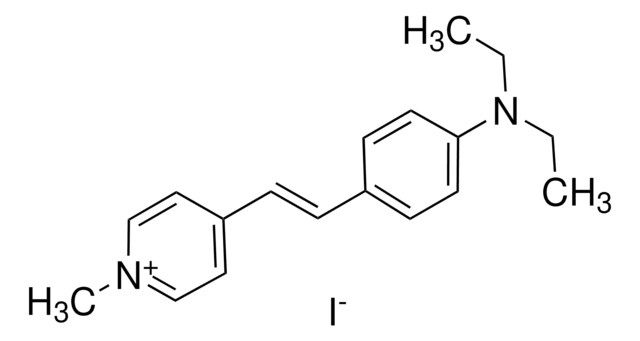83702
Rhodamine 123
BioReagent, for fluorescence, ≥85% (HPLC)
Sinónimos:
2-(6-Amino-3-imino-3H-xanthen-9-yl)benzoic acid methyl ester
About This Item
Productos recomendados
grado
for fluorescence
Nivel de calidad
Línea del producto
BioReagent
Análisis
≥85% (HPLC)
formulario
powder
impurezas
≤10% water
solubilidad
ethanol: 20 mg/mL, clear, red
idoneidad
in accordance for fluorescence
cadena SMILES
Cl[H].COC(=O)c1ccccc1C2=C3C=CC(=N)C=C3Oc4cc(N)ccc24
InChI
1S/C21H16N2O3.ClH/c1-25-21(24)15-5-3-2-4-14(15)20-16-8-6-12(22)10-18(16)26-19-11-13(23)7-9-17(19)20;/h2-11,22H,23H2,1H3;1H
Clave InChI
MYFATKRONKHHQL-UHFFFAOYSA-N
¿Está buscando productos similares? Visita Guía de comparación de productos
Categorías relacionadas
Descripción general
Aplicación
- as a substrate for P-glycoprotein (P-gp) to read out functional transporter activity in fluorescent accumulation assays
- to label the cells for estimating the P-gp expression by flow cytometry
- in transport studies, was added to the apical to basolateral (AB-transport) or basolateral to apical (BA-transport)
- the detection of mitochondrial membrane potential (ΔΨm)
Acciones bioquímicas o fisiológicas
Otras notas
Código de clase de almacenamiento
11 - Combustible Solids
Clase de riesgo para el agua (WGK)
WGK 3
Punto de inflamabilidad (°F)
Not applicable
Punto de inflamabilidad (°C)
Not applicable
Equipo de protección personal
Eyeshields, Gloves, type N95 (US)
Certificados de análisis (COA)
Busque Certificados de análisis (COA) introduciendo el número de lote del producto. Los números de lote se encuentran en la etiqueta del producto después de las palabras «Lot» o «Batch»
¿Ya tiene este producto?
Encuentre la documentación para los productos que ha comprado recientemente en la Biblioteca de documentos.
Los clientes también vieron
Artículos
Nitric oxide (NO) as a signal transporter in neurons, endothelial cells and in the immune system.
Nuestro equipo de científicos tiene experiencia en todas las áreas de investigación: Ciencias de la vida, Ciencia de los materiales, Síntesis química, Cromatografía, Analítica y muchas otras.
Póngase en contacto con el Servicio técnico











